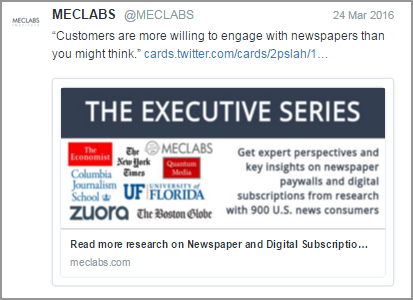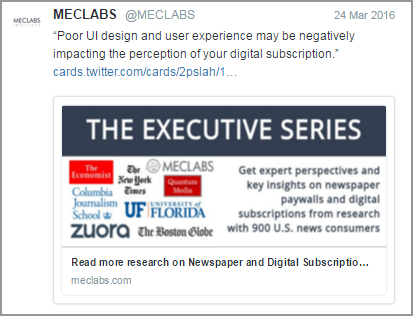Here at MECLABS Institute, parent company of MarketingExperiments, we never stop testing. Whether it be subject lines, email copy, Web clinic format or landing pages, a day rarely goes by where there isn’t an experiment taking place on our campus. This culture of testing extends far beyond just the optimization team — it permeates the entire organization.
Case in point, a recent Twitter test imagined by our resident marketing operations specialist, Walker Ragland. Walker is famous around the Institute for his quick wit, strong marketing copy and love of all things Valdosta, Georgia. You might recognize Walker from last month’s MECLABS Live Optimization webinar, where he provided viewers with actionable tips on improving the performance of their site banners.
“Social media is still a new frontier for this company, so I’ve been encouraged with a generous budget to test out what works and what doesn’t work as far as different aspects of the creative of social,” Walker told me.
Armed with this healthy testing budget and a strong team supporting him, Walker has recently set out to test some of our social media sends across multiple platforms.
For this experiment, Walker wanted to test which Twitter messaging approach would work best when promoting the newest issue of the MECLABS Institute Executive Series.
“This is a relatively new product, so I tried three different copy options with this test,” Walker said. “The first option used a quote from the piece, and it was a positive quote. The second featured a quote based on a negative point. And then the third option was just a standard offer.”
Take a look at the three approaches that he tested and see if you can correctly pick the winning treatment.
Version A: Positive messaging
For this treatment of the MECLABS promotional tweet, Walker used copy that emphasized an encouraging discovery for subscription-based businesses that the MECLABS team found from their survey of 900 U.S. news consumers. This copy teased this finding, reading, “Customers are more willing to engage with newspapers than you might think.”
Version B: Descriptive messaging
For Version B, Walker simply stuck with the facts, describing what a click would get for visitors. Those who saw this tweet read, “Get access to your complimentary issue, featuring 20 pages of business and consumer insights from industry experts.”
Version C: Negative/pain-point messaging
For Version C, Walker took the opposite approach as Version A. Instead of relying on optimistic messaging, Walker focused on a potentially damaging finding from the team’s research: “Poor UI design and user experience may be negatively impacting the perception of your digital subscription.” Walker hoped that emphasizing this particular paint point might lead readers to download the Executive Series.
Results
Before Walker revealed the results, I asked him which version he thought would win at the onset of the test.
“I suspected that the positive quote would win,” Walker said. “I suspected that this quote would give this otherwise struggling industry a reason to click.”
For this specific industry, I was inclined to agree with Walker. Newspapers have had well-documented struggles adapting to the times and competing with the onslaught of free news available online. I thought that the glimmer of hope Version A provided, rather than the kick to the shins inflicted by Version C, would make it the winning treatment.
This shared hunch, when compared to the actual results below, clearly demonstrates how important it is for us to test everything, even strong hunches anchored in sound reasoning.
“The results were not what I suspected,” Walker said. “The overwhelming support went to Version B. The regular, promotional style copy won by a large margin.”
In fact, the Version that both Walker and I chose to win — the option based on positive messaging — was the lowest performing treatment by far.
As a reader, you may tire of hearing us constantly pounding the drum of “clarity trumps persuasion.” However, treatment after treatment, test after test, year after year, we find that this mantra holds true. Being direct and specific about the value of the ask will always beat manipulating your way into a click through “salesy” and unnecessary creativity.
Walker summed up the results by saying, “I think that consumers are wary of the bait-and-switch, and these quotes might have seemed a little baity, rather than talking specifically about what they were getting. The promotional tweet made it very clear what they were receiving.”
Thanks for the great test, Walker. We look forward to sharing more of your research with the readers here on the MarketingExperiments Blog!
You can follow Ken Bowen, Managing Editor of MarketingExperiments, MECLABS Institute, on Twitter at @KenBowenJax.
You might also like:
Value Proposition: How to use social media to help discover why customers buy from you
Social Media Microsite Test: 3 lessons based on a 154% increase in leads
Social Media Optimization: Engineering contagious ideas







